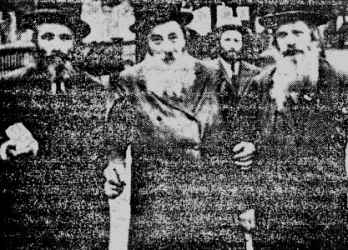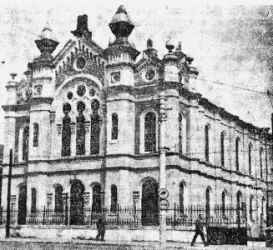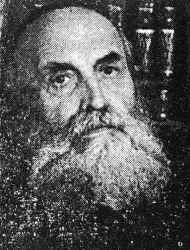 |
 |
 |
|
|
[Page 31]
Rebbes and Hassidim in Transylvania
The waves of the Jewish spiritual currents of the 18th and 19th centuries did not miss Transylvania on the western side of the Carpathians - the geographic confluence of these streams. A proof was the arrival of the father of the Author of the Tanya (Rabbi Baruch, the father of Rabbi Shneur Zalman of Liadi)[16] to the city of Sălaj during his wanderings in Transylvania. He later served there as a teacher of young children, and found his final resting place there. His wanderings can be attributed to his opposition to the concept of Hassidism and his escape from his son. His son later came to supplicate over his grave.
It is told of the joint visit of Rabbi Levi Yitzchak of Berdichev and Rabbi Aharon of Zhitomir to the city of Károly in Transylvania, apparently, to disseminate the idea of Hassidism. The Torah genius Rabbi Meir Yehuda, who lived in that city, did not agree to welcome the visitors. When the two of them entered his room, he jumped out the window and escaped from them.
Maramures, the mountain district at the foot of the Carpathians, is the cradle of Hassidism in Transylvania. According to legend, the Baal Shem Tov sent one of his students, Rabbi Kopel of Kolomyja, to plant Hassidism there. Hassidim tell that when the Baal Shem Tov left Kitov and wandered to the Carpathian Mountains with an entourage of his students, he looked at the Maramures situation on the other side of the tall Carpathians, stood in amazement and said to his students, “This is the beautiful garden of Rabbi Kopel. Guard this garden.” Indeed, Rabbi Kopel settled in Maramures, and his descendents also followed the command of the Baal Shem Tov.
There were two courts and capitals of Hassidism in Transylvania - Visnitz (located in Grosswardein) and Sighet, which represented strict Hungarian Hassidism through theBeis Midrashof the Teitelbaum dynasty. However, the champion who planted Hassidism in Transylvania was the general rabbi, the author of “Baal Mareh Yechezkel,” the gaon Rabbi Yechezkel Panet[17]. During the course of his duties, he wandered from place to place, established communities, appointed rabbis and shochtim, enacted rules, and established the bounds of Judaism. Along with this, he brought the idea of Hassidism, to which he was attached, with him to every place (see the responsa book Mareh Yechezkel, section 104).
Nevertheless, Hassidim did not break through the heart of the country and did not spread across the region. Most people continued to oppose Hassidism, for the main source of influence
[Page 32]
in most regions of Hungary remained the capital of Torah, which was Pressburg, which also etched its mark on this region. Hassidism was restricted to the districts close to the Carpathians (Munkacz and Sighet), as well as the vineyard and winemaking district that included Kaliv, where Rabbi Yitzchak Izak Taub, the founder of Hassidism in Hungary, settled. In his book “From the Chatam Sofer to Herzl,” Dr. Zvi Zahavi writes that in the “Di Velt” newspaper Dr. Ronai describes the history of the song “The Rooster is Calling,”[18] that turned into a national song of the Hungarian Jewry and strengthened the longing for Zion. Rabbi Izak Taub of Kaliv, who lived during the 18th and the beginning of the 19th century, learned a popular song from a Hungary shepherd. Since he liked it, he wrote the words that elicit longing for the rise of Israel and the return to Zion. The Jews of Hungary sang this song at weddings and celebrations from the 18th century to this day. Ronai translated the song into German for the readers of “Di Velt”. Dr. Yosef Patai later translated the song into Hebrew, as follows:
The Rooster is Calling
Day is dawning
In the green forest - in the green meadow
A bird is wandering about.How lovely is the bird
Oh, how lovely is the bird
With yellow feet and a golden beak
The bird waits for me.The rooster is calling
Day is dawning
The Temple will be rebuilt
Zion will be restored.Oh, when will the generation be redeemed?
And we will sing a new song there
And ascend in joy
The time has already come!Wait, wait oh bird
Oh, if you wait, oh bird
If G-d has designated you
I will rejoice with you in freedom.
This song was sung in Hungarian at celebrations around the table and at weddings by the Rabbi of Kaliv, the founder of Kiryas Kaliv in Rishon Lezion.
The cities of Transylvania were a refuge for many Jews of Poland, Galicia and Russia, who settled there during the time before the Holocaust. During the opening period of the First World War, the armies broke through the areas across the Carpathian Mountains, where hundreds of thousands of Jews had lived for generations. Now, with the occupation,
[Unnumbered page of photos after page 32]
|
|
|
|||||
| Rabbi Yisrael Hager of holy blessed memory, the Rebbe of Visnitz (in the middle). To his left is his son Rabbi Menachem Mendel of holy blessed memory, the head of the rabbinical court of Wysowo | The Beis Midrash of Rabbi Yisrael of Visnitz in Grosswardein. Because of the Holocaust, it was not dedicated. Today it serves as a government lumber warehouse | The gaon Rabbi Akiva Sofer of holy blessed memory, the head of the rabbinical court of Pressburg. He was the son of the author of “Shevet Sofer” |
|
|
|
|
|||||||
| The Admor Rabbi Baruch, may he live, of Seret-Visnitz. The founder of Shikun Visnitz in Haifa and the head of Yeshivat Yachel Yisrael | Rabbi Chaim Meir, may he live long, the founder of Kiryas Visnitz in Bnei Brak and the director of the Yeshiva | The gaon Rabbi Yosef Tzvi Dushinsky of holy blessed memory, of Jerusalem. The former head of the rabbinical court of Galati and Chust. The rabbi of Orthodox Judaism in the land of Israel, and the successor of Rabbi Yosef Chaim Sonnenfeld of holy blessed memory | The gaon Rabbi Shmuel David Ungar of holy blessed memory, the head of the rabbinical court of Nitra, formerly the head of the rabbinical court of Surany |
[Page 33]
many were wandering through the world, and tens of thousands of these war refugees ended up in Hungary and settled there. Masses of Hassidim settled in alleyways of old houses, taking refuge in the courts of the miracle worker Rebbes, and clinging to the way of life of their fathers from Bukovina and Galicia, which were located on the battlefront. Several giants of Hassidim found refuge there, including Rebbes and grandchildren of famous Rebbes.
Translator's Footnotes
by Yehuda Schwartz
The Rebbe of Dolina. His Beis Midrash was deep in the courtyard, under the shade of trees. There were bookcases along the walls of theBeis Midrash filled to the ceiling with valuable books. The rabbi played an important role within Orthodox Jewry of Halmeu, and was considered to be one of the most accepted and prominent Admorim in the entire region. He was beloved and pleasing to his Hassidim, and his admirers basked in his presence. As a rabbi and pastor, he was filled with feelings of responsibility; as a man of cold logic and a warm heart, he enchanted everyone who entered his home. Hassidim and men of good deeds, Sabbath and festival Jews along with toiling weekday Jews[1], sat around his table on Friday nights and Saturdays.
His son Reb Chaim Izakl, who lived in the world of Abaye and Rava[2], excelled as a genius and as a fearer of Heaven, and wore a spodek[3] even on weekdays, was chosen as a rabbinical teacher under the rabbi of Slutszana (Sălăjeni ?). He excelled in his talent in analyzing Talmudic discussions. His novellae and commentaries earned him fame within the Jewish communities.
Rabbi Shmelke Liper was the grandson of the Tzadik and renowned miracle worker Rabbi Mordechai of Nadworna. He knew no weariness in his Divine service. A holy fire burned constantly within his soul. He was not only careful about every jot and tittle of the Shulchan Aruch [Code of Jewish Law], but was also very stringent in many matters. His generous character traits were also very pronounced, whether with regard to charity, or with regard to his modesty and care in interpersonal relations.
On the eve of the Sabbath, as he hastened to the mikva [ritual bath] accompanied by his sons in order to purify himself for the honor of the Sabbath, everyone looked at him with reverence. Many worshippers streamed to hisBeis Midrashin order to see his great enthusiasm and listen to his beautiful prayers. When he lifted his hands upward and called out with devotion “Hodu Lashem Ki Tov”[4], he brought his worshippers to spiritual excitement, and it was as if he was trembling before Heaven…
His only daughter Feiga married Reb Leibish Ber Halpert, who was
[Page 34]
a well-known rabbi and scholar. He was a wonderful expositor with extraordinary power of persuasion. In his fine sermons and lessons that he presented in the Great Synagogue every Sabbath afternoon, his unusual talents as a preacher and sermonizer who desired to raise the stature of Torah and the commandments later became evident. Today he serves as a rabbi in north Tel Aviv.
The Cavniker Rebbe[5] (Kopel). His name testifies to his piety and religiosity, even though he never actually utilized his title, and never earned his living from the rabbinate. He never conducted Hassidic table celebrations, and people did not come to him with requests as they would do with a holy man. He was wealthy, and lived in a large courtyard that contained houses that he rented. He owned estates. In his courtyard there was a barn with a large warehouse of seeds and grains.
The Great Synagogue
A long alleyway led out from the large square in the center of the town between the Catholic and Reform churches. This square served as the marketplace every Thursday. The alleyway led to the path that led to the Great Synagogue. A stream covered in boards led the length of the alleyway. The synagogue building was large and beautiful. The services were conducted according to the Ashkenazic rite. Nobody who conducted the services would dare to alter this custom. Services were conducted in the anteroom every morning and evening on weekdays. This was the source of spiritual enjoyment for the people, the source from where they drew the strength and ability to live and continue on.
The synagogue was full of worshippers on Sabbaths and festivals. When they worshipped and listened to the beautiful prayers, they would forget the outside world with its tribulations and bask in the supernal worlds, in the world that is fully spiritual.
I recall that during my childhood, I went to the synagogue along with my parents of blessed memory on the first day of Selichot[6]. The streets were still enveloped in darkness, the stars twinkled in the sky, and the synagogue courtyard was covered in light. Lanterns spread light through the darkness from all the windows of the synagogue. The dark shadows of men and women hurried to the houses of worship for Selichot.
The rabbis of the city delivered their official sermons from the synagogue pulpit on Shabbat Hagadol, Shabbat Shuva, Shabbat Nachamu, and the 7th of Adar.[7] The Jews of the town set the prayer times on the sermon days so that they would all be able to come and listen.
There was a slaughterhouse for fowl behind the synagogue. On the right side of the entrance of the alleyway were the home of the shochet [ritual slaughterer] and the butcher shops of Elberger and Gewirtz.
[Unnumbered page following page 34]
|
|
| Here, the Jewish residents of the town are gathered together before being transferred to the Sălaj Ghetto |
|
|
|||
| The interior of the Great Synagogue of Sălaj. Here, the Jews of Halmeu endured the cruelest forms of torture before entering the ghetto. The Hungarian gendarmes conducted stringent body searches and a search of personal belongings |
||||
[Page 35]
On the left side was the mikva in which people went to purify themselves from the filth of the weekdays. Reb Meir Parnatzi was responsible for caring for the bathhouse. He was a quiet, G-d fearing man, dedicated to his work. He had talented children. His daughter is in Israel.
Reb Moshe Jeremias, Reb Yisrael Mermelstein, Reb Menachem Gotlieb, Reb Meir Roth, and Reb Yosef Rozat served as heads of the community.
The following people served in the communal leadership: Reb Alter Landau, Reb Baruch Hendler, Reb Shaima Greenfeld, Reb Tzvi Hendler and his brother Reb Yosef Hendler, Reb Menachem Steinberger (the son-in-law of Reb Aharon Kahana), Reb Daniel Rotsein, Reb Asher Lemel Steinberger, and Reb Betzalel Friedman.
The following people excelled as successful gabbaim [synagogue trustees]: Reb Yitzchak Meir Sholoman, Reb Meshulam Fishweis, Reb Meir Braun, and Reb Shmelke Mandel.
Translator's Footnotes
|
|
JewishGen, Inc. makes no representations regarding the accuracy of
the translation. The reader may wish to refer to the original material
for verification.
JewishGen is not responsible for inaccuracies or omissions in the original work and cannot rewrite or edit the text to correct inaccuracies and/or omissions.
Our mission is to produce a translation of the original work and we cannot verify the accuracy of statements or alter facts cited.
 Halmeu, Romania
Halmeu, Romania
 Yizkor Book Project
Yizkor Book Project
 JewishGen Home Page
JewishGen Home Page
Copyright © 1999-2024 by JewishGen, Inc.
Updated 6 Oct 2013 by LA